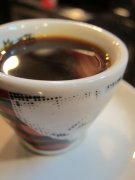Behind the success of Starbucks

The waiter at the first Starbucks store is smiling.
Starbucks, headquartered in Seattle, Washington, USA, has been developing for nearly 40 years. Without advertising, Starbucks has expanded into the largest coffee shop chain in the world, which has become a miracle in the industry. On a rainy weekend afternoon, the reporter visited the first Starbucks store at 1912 Park Market Street in Seattle.
Starbucks No.1, like the Pike Fish Market across the street, has long been one of Seattle's business cards. There are a lot of people outside the shop, and it's very crowded inside. The long line is just for a taste of coffee here. Two days later, at 9: 00 p.m., the reporter came here again. It's not all dark, and the shop is still open, but there is less noise, so we can take a closer look at the number one Starbucks store in the world.
The shop is rectangular and covers an area of about 60 square meters. There are no tables and chairs for customers to sit down for coffee, let alone the fashionable furnishings of other stores. There are two maps of the world on the wall near the counter, one of which has a card in the bottom frame indicating that as of October 4, 2009, Starbucks had 16082 stores around the world.
Reporters who usually don't drink coffee also asked for a cup at this time, accompanied by wisps of fragrance, savoring the legendary start-up story of Starbucks from here. More than 40 years ago, a businessman named Alfred Pitt was doing brisk business in Seattle selling coffee beans and related equipment. Inspired by this, Baldwin, an English teacher who knew Peter, Siegel, a history teacher, and Buck, a writer, teamed up to open the first coffee bean store in Seattle on March 30, 1971. At first, the store was located at 2000 West Street, and then moved to its current location. After several discussions, the name of the shop was inspired by several partners from American novelist Melville's masterpiece Moby Dick, and they finally agreed to name the name of Star, the coffee-loving first mate on the whaling ship Piguard in the novel.
Howard Schultz joined Starbucks in 1982 as director of retail and marketing and was the first to suggest that Starbucks should sell not only coffee beans but also steam-pressurized drip-filtered coffee. Several entrepreneurial partners initially rejected the idea. For them, coffee should be brewed in their own homes, and entering the beverage market goes against the original intention of starting a business. Schultz, who stuck to his ideas, opened a new coffee shop in April 1986 and bought Starbucks the following year. Since then, Starbucks has increased its business content and expanded rapidly, leaving Seattle to open a branch in Vancouver, Canada. In 1996, Starbucks opened its first store outside North America in Tokyo, Japan. So far, Starbucks has more than 17000 stores in about 50 countries and regions around the world.
In the first Starbucks store, the waiter talked enthusiastically with the reporter. Starbucks' corporate culture is to encourage waiters to communicate with customers. In fact, one of the secrets of Starbucks' success is to make it a "third communication space" different from home and office through a series of changes and innovations. According to Schultz, what Starbucks sells is actually an "experience". In this experience of coffee culture, coffee itself is not even important.
During the conversation, the reporter learned that Starbucks had also encountered accusations of "unfair competition", labor disputes, environmental damage and even explosions in the course of its development. Starbucks has been forced to close nearly a thousand stores in China since 2008 against the backdrop of the financial crisis. Under intense pressure from competitors, Starbucks also began offering free wireless Internet access in stores in the United States and Canada in July this year. Starbucks executives want to run alcohol in the store, but there is a heated debate about the company's cultural value-in fact, big is still a big problem.
China Coffee Trading Network: www.gafei.com
Important Notice :
前街咖啡 FrontStreet Coffee has moved to new addredd:
FrontStreet Coffee Address: 315,Donghua East Road,GuangZhou
Tel:020 38364473
- Prev

There are 13 kinds of coffee. How many do you know?
Coffee has become a worldwide drink now, and more and more people like it. When you are tired, a cup of coffee can cheer you up. The main ingredient of coffee is caffeine, which also contains some protein, sugar, fat and so on.
- Next

A good cup of coffee starts with farmers.
The term "consumer rights" has taken root, especially in contemporary China, where counterfeit goods are rife. In contrast,"consumer responsibility"
Related
- Beginners will see the "Coffee pull flower" guide!
- What is the difference between ice blog purified milk and ordinary milk coffee?
- Why is the Philippines the largest producer of crops in Liberia?
- For coffee extraction, should the fine powder be retained?
- How does extracted espresso fill pressed powder? How much strength does it take to press the powder?
- How to make jasmine cold extract coffee? Is the jasmine + latte good?
- Will this little toy really make the coffee taste better? How does Lily Drip affect coffee extraction?
- Will the action of slapping the filter cup also affect coffee extraction?
- What's the difference between powder-to-water ratio and powder-to-liquid ratio?
- What is the Ethiopian local species? What does it have to do with Heirloom native species?

